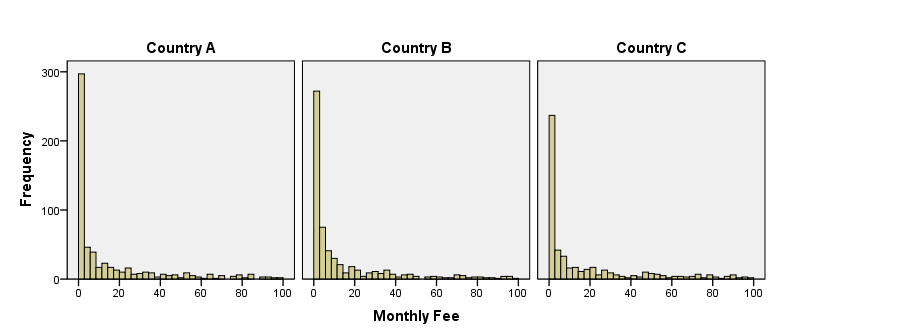The main goal of a CBC study run in three East-European countries (A, B and C) was to estimate potential of a special telecommunication service. Choice selectivity and propensity to a class of tariff were by-products of the survey.
The tested tariffs spanned a range of up to more than 20-fold of the lowest fee. This was the reason for using a multi-level class design of CBC exercises. The classes have been designed so that all neighboring top-level classes had sufficient overlap in attribute values. Unacceptable combinations were excluded by introduction of lower-level classes. For the purpose of this presentation the top-level classes have been united into 4 main classes named XS, S, M and L used as behavioral classification of the sample segments.
Each respondent took a CBC exercise with the range of profiles mainly from the class they most inclined to in the preceding CBS - Choice Based Sampling exercise.
As was mentioned on page Product Utility Interpretation, elasticity of substitution in respect to a quantity of a benefit or detriment is a generalized sensitivity measure of an individual to the quantitative attribute in choice of the product. It is approximately constant in a (sufficiently narrow) range of values. This also holds in this study for monthly fee in the range of tariff class selected by respondent as the most suited. However, the dispersion among individuals in the sample is enormous as can be seen in the picture below. The distribution resembles a heavy-tailed extreme value distribution.

It is evident a simple mean of individual elasticities is not usable to characterize the sample or its segment. Median as a robust aggregate characteristic was chosen. The results are in the picture below.

Potential customers of the starter level services XS in country A are the most sensitive to monthly fee. The sensitivity maximum is shifted to higher level services in countries B and C where higher percentage of customers are demanding more than just the basic call services.
Top tariffs L offered in countries A and B are used or planned mostly by well-off customers who are little sensitive to monthly fee. The desire for top-level services in country C is more frequent among common population that is more price sensitive.
Sensitivity to mobile data allowance is, on average, about the same in all 3 countries except its distribution among segments. This is due to differences in tariff settings in the countries. An important point to be noticed in countries A and B is the sensitivity to mobile data allowance is comparable to (in tariff M) or even higher (in tariff L) than sensitivity to monthly fee. An acquirement policy could be based on this finding.
Sensitivity to price of the special service carries features similar to the monthly fee. Only it is lower since this price is perceived as an addition to the overall price, i.e. it makes an increment in the region of diminishing product indirect utility. Since interest in the special service was low, precision of the computed elasticities is not as good as for monthly fee and data allowance attributes.
Elasticity has the attractive feature of measuring responsiveness to the attribute value in ratio (percentage) terms which makes it invariant to the units of attribute measurement. This makes possible comparison of relative influences of two or more attributes. A simple static plot of elasticities for appropriately selected product classes and target segments can give quick view of dynamic changes in product performance when attribute values are changed. With supplementary information on the product properties and market performance the manager can infer which attribute changes can have higher or lower impact.
Attribute elasticities can be estimated only for quantitative attributes. As similar measure for nominal attributes is not available comparison of quantitative with nominal attributes is not possible. The estimation using partial derivatives completely neglects acceptances or shares of the products. The researcher must be very careful which data is used in the estimation of elasticities. This is especially true when part-worths obtained from HB estimation are used. They may contain a large portion of "borrowed" data, it is the data that might come from a different target group the elasticity is meant for.